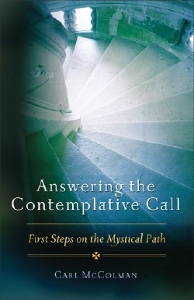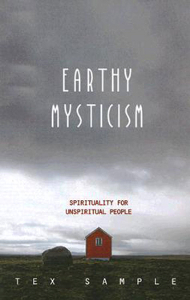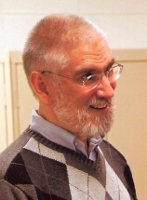| Lists:
Sets of instructions. How-to steps.These are really helpful if you are putting together a book shelf or bicycle or even if you are trying to fix a problem on a Linux operating system like Xubuntu. I’ve always been a bit skeptical about such things as they relate to personal or spiritual things. They tend to imply, “If you’ll only follow these X number of steps, you’ll be okay – you’ll succeed.” I just can’t believe such things are that simple, that cut and dried, that black and white. And yet, I wonder how much money is spent each year by people trying to find the list that will answer their questions and fix their problems. I bet it’s millions of dollars. |
 |
 |
|
|
||
| One Book: | ||
I received a copy of Carl McColman’s Answering the Contemplative Call: First Steps on the Mystical Path to review from the good folk over at The Speakeasy. I requested a copy as I’ve been interested in reading some different authors with different perspectives. Plus, more importantly, mysticism is something that has become of interest to me in recent years, partly because “mystical language” and the seeking by so many of the “mystical path” have become prevalent.
I thoroughly enjoyed Part One of the book, entitled “Recognizing the Call.” In it, McColman does a good and interesting job of defining the mystery of contemplation or mysticism while leaving the definition open enough for others to have mystical experiences that are a bit different. He does this by giving us glimpses into the different contemplative lives of people such as Bernard of Clairvaux, Evelyn Underhill, Teresa of Avila, Richard Rohr, and Meister Eckhart, just to name a few. He even spends one chapter, “Three Tales of Awakening,” looking at Thomas Aquinas, Julian of Norwich, and Thomas Merton.
Part Two, “Preparing for the Journey,” is a focus on preparing for the “adventure of falling ever more deeply in love with the Divine” (pg. 43). For me, this section was still somewhat enjoyable, but he over used and over extended the metaphor of preparing for a trip to a distant place to the point of being too “whimsical” (his word from the “Introduction”) or cheesy (my word).
The deeper I got into Part Three, “Embarking on the Journey,” the less connected with the book I became. He went to great pains to say that everybody will do things differently, which I appreciate. But then he’d counter with something like, “But you really ought to follow these steps.” For instance, McColman did a good job in the chapter on “Befriending Silence” to make clear that we can never fully find silence. Even in nature, we’ll hear the sounds of nature. As much as we try to silence our minds, our minds are likely to keep chattering except for an occasional period (possibly very brief period) of silence. Then in the chapter, “Praying the Silence,” he countered with a list (which I have been upfront about not liking):
- Set aside a time of uninterrupted silence;
- Have good posture;
- Have good breathing;
- Focus on an object and / or repeat a phrase or a word.
I know this is helpful for some people. I have even led folks through some of these steps as I know it works for them. My frustration is that it feels like he implies if I’m to respond to the call of contemplative prayer, I need to do this. This has not worked for me. I’ve tried it again and again and I find it far from nurturing for me (at least in this time of my life).
|
|
| The Other Book: |
All the while that I read McColman’s book – both the parts that I loved and the parts I liked less – one book kept coming to mind: Tex Sample’s Earthy Mysticism. This is a book I purchased on my own a few years ago to use as part of a faith study with a group called The Society of St. Simeon at First United Methodist Church in Wichita Falls, Texas (as an aside, part of our opening liturgy for each session was very similar to McColman’s steps listed above).
In all honesty, Tex’s understanding of mysticism has become my understanding for me. The ways he has had mystical moments are like mine. Thus, it is no wonder his book kept coming to mind. For instance, he writes in the Introduction entitled “A God Who Will Goose You:”
I am not helped much by conventional approaches to spirituality. I find it almost impossible to do “devotions.” Daily Bible study in the sense of devoting twenty to thirty minutes a day never worked for me. I cannot get around to scheduled times for prayer on my knees with head bowed. I find labyrinths and prayer beads boring. I am ever and again distracted in silent meditation. I simply cannot sustain a spirituality based in such things. Yet, Bible study, prayer, worship, and Eucharist form the heart of my practices, but it is a different spirituality (pg. xiv).
What I love about his book after the introduction is that they are essentially just stories from his life in which he has in some way been surprised by God who arrived “in the ordinary and the seamy.” They are “about mystical moments when clearly the only thing that finally matters is this God who will never leave us alone, especially in the ordinary and angular places of life” (pg. xv).
Through stories like the death of his son, the conniving of an insurance salesman, participating in a march on Selma, and comforting his vomiting wife, Tex creates opportunities for us to see God in our own painful, mean, inspiring, and mundane events. And for me, one of the beauties in the ways he tells these stories is that he seldom says, “Well, this is how I experienced God.” More often than not, he kind of leaves it hanging (like some of Jesus’ parables) for us to wrestle with where God was “goosing” Tex in the story and where God might be goosing us. We are left with deciding what is “mystical.” We aren’t told what is and is not or whether we arrived at it in a “correct” way.
|
|
| Contemplatives: |
I experienced a real epiphany in McColman’s book. I noticed that the word, “contemplative” (aka mystic), is based on the word, “contemplate.” Contemplate. To know God more fully, we must contemplate the mystery of God. We must consider again and again this God that will goose us.
I can’t say for sure, but I’d bet that Tex Sample didn’t always know that the stories he told were mystical in the moment. That has certainly been my experience. It has been most often in retrospect that I more fully see the action of God. It is in contemplation that God becomes more apparent.
|
|
| Both Books: |
McColman’s book has much to offer, especially for people who are predisposed to living out their spiritual life in a more disciplined way. It provides many insights for anybody, but the last part was less edifying for me.
No matter your predisposition, I thoroughly recommend Sample’s book. It may open you to new ways of knowing the mystical life.
|
|
|
| About the Authors: | |
|
He studied Christian meditation at the Shalem Institute for Spiritual Formation, and received additional training in the art of spiritual direction from the Institute for Pastoral Studies in Atlanta. He is a professed member of the Lay Cistercians of Our Lady of the Holy Spirit, a community under the spiritual guidance of the Trappist monks of the Monastery of the Holy Spirit. As a Lay Cistercian, his spirituality is ordered toward what Walter Hilton called “the mixed life” — devoted to the practice of contemplation within the context of marriage and family, outside of a traditional monastery. Carl lives near Stone Mountain, Georgia, with his wife and stepdaughter. |
Sample is a freelance lecturer and speaker in North America and overseas and has been active throughout his career in both the church and in the community. While living in Arizona, he was heavily involved in the Valley Interfaith Project, a broad-based organizing effort associated with the Industrial Areas Foundation. He was also active in the Arizona Interfaith Movement, an interfaith group that includes 25 different faith traditions. Sample is married to Peggy Sanford Sample, who is a watermedia artist and a musician. They have three children, one of whom is deceased. |
|
|
|
| Disclosure of Material Connection: I received Answering the Contemplative Call free from the author and/or publisher through the Speakeasy blogging book review network. I was not required to write a positive review. The opinions I have expressed are my own. I am disclosing this in accordance with the Federal Trade Commission’s 16 CFR,Part 255. | |



